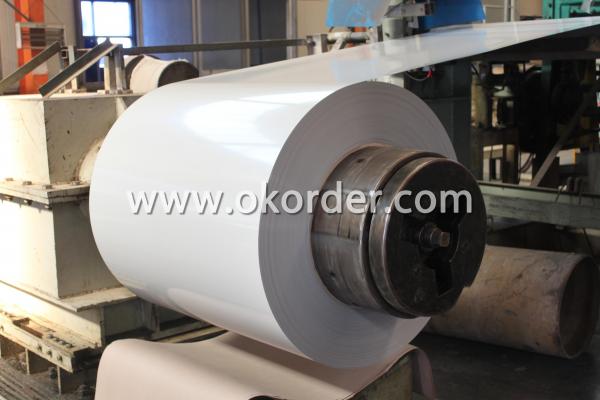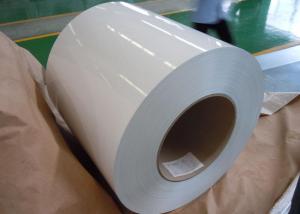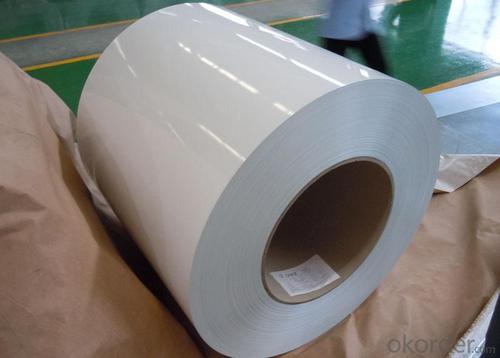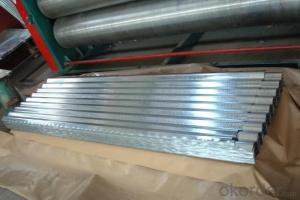Best Quality for Prepainted Aluzinc Steel Coil-JIS G3322
- Loading Port:
- China Main Port
- Payment Terms:
- T/T or L/C
- Min Order Qty:
- 50mt m.t.
- Supply Capability:
- 100,000 mt/year m.t./month
OKorder Service Pledge
OKorder Financial Service
You Might Also Like
Best Quality for Prepainted Aluzinc Steel Coil-JIS G3322
With GL as base metal, after pretreatment (degrease and chemical treatment) and liquid dope with several layers of color, then after firing and cooling, finally the plate steel is called pre-painted aluzinc steel. Pre-painted Aluzinc steel is good capable of decoration, molding, corrosion resistance. It generally displays superior workability, durability and weather resistance.
General Information Of Best Quality for Prepainted Aluzinc Steel Coil-JIS G3322
|
Thickness |
0.23-1.2mm (BMT) |
|
Width |
900-1250mm |
|
Alu-zinc Coating |
50-150g/m2 |
|
Internal Diameter |
508mm or 610mm |
|
Color |
According to RAL color fan |
|
Coil Weight |
4-8MT |
|
Quality |
Commercial and structural quality |
|
Paint |
Polyester paint for topside, epoxy for reverse |
|
Standard |
JIS G 3322, ASTM A755M, EN 10169 |
|
Package |
Full wrapped with anti-damped paper inside, iron sheet wrapped outside, and bundled by iron strips |
|
Base Steel Grade |
SGCC, SGCD, DX51D+Z DX52D+Z; S200GD, S220GD, S280GD,S350GD,CS,FS,SS |
Technical Data Of Best Quality for Prepainted Aluzinc Steel Coil-JIS G3322
|
Chemical Composition |
C |
Si |
Mn |
P |
S |
|
0.04-0.06% |
0.01-0.03% |
0.18-0.22% |
0.014-0.016% |
0.006%-0.009% |
Technical Data Of Best Quality for Prepainted Aluzinc Steel Coil-JIS G3322
|
Yield Strength |
(Mpa) 280-320 |
|
Tensile Strength |
(Mpa) 340-390 |
|
Elongation |
20%-30% |
|
Reverse Impact |
9J |
|
T-bending |
≥2T |
|
Pencil Hardness |
≥2H |
|
Duration Of Salt Spray Test |
500 H |
|
Bending At 180 Degree |
No crack, purling and fraction |
Application Of Best Quality for Prepainted Aluzinc Steel Coil-JIS G3322
It can be widely used in transportation, light industry, civil usage and farming. It is also the perfect building material in construction for making steel roofing, corrugate sheet, sandwich panel for wall or roofing, facade wall,shutters and home appliance.


Packaging & Delivery
1. Packaging Detail:
The packing of coils consists of anti-damp paper, PVC film, hardboard paper, steel box, strapped with steel strips, fitted with locks and edge protectors and guarantees the optimal condition of the delivered goods. Each coil can be additionally fitted with wooden/steel skids(eye to the side) or wooden pallets(eye to the sky).
2. Delivery Detail: As customer requested

- Q: I was looking at my Great-Grandfather's immigration form from when he immigrated from Scotland and he listed his occupation as a steel dresser. What does a steel dresser do?
- The steel dresser was a person who would clean the freshly made cast steel pieces at a foundry/ steel factory. Usually when the steel comes out it will have some extra bits and pieces sticking out that need to be removed. The steel is melted and cast into shape so there will be like a little raised line where edges of the mold met or a few blobs sticking out where the hot steel dripped over the edge or something. The dresser was the person who got rid of that kind of stuff to make a more finished/even product.
- Q: How can I tell the wear resistance, strength, ect from the name of the steel?how could I tell the difference between 420 and 440 steel. what does the HC in 420 HC steel mean? what do the numbers and letters in s30v steel mean?
- Larry gave a good answer. As for the HC, it means High Carbon.
- Q: how simple is it to take it scrape steel and recyle it. does annybody know the process . i want to do this but first i need some basic information. as far as i know first to melt the steel and in a furness on high heat and than give the shape that customer wants. how right or wrong am i . i want to start on a very small scale.
- right. May need some coke to remove iron oxide
- Q: Ik iron was too heavy but could steel bolts have been used. I can see iron dissolving at surface when to be a danger it needs to reach the core of sun.. But so does steel go deeper in(w.e alloy turned from iron)..I wanna know which would be worse iron..or upgraded iron(steel) and if the steel would have worse effects than normal iron..Im sure if we used iron we used steel
- Reach the core of the sun? No material can even get past the corona of the sun, where did you hear Ulysses went to the core? The spacecraft Ulysses orbits the sun at about 5 au. that's 5 times the earths orbit.. Steel is used instead of Iron because steel is much stronger and therefore you can use smaller 'bolts' to accomplish the same thing, reducing the weight. As far as most structures are concerned steel is better than plain Iron in every category. So Iron is worse i guess.
- Q: i wanna know all the similarities between iron and steel
- 1. Both victim of corrosion
- Q: How are steel coils used in the production of metal ceilings?
- Steel coils are used in the production of metal ceilings as they serve as the raw material. The steel coils are processed and shaped into the desired dimensions and patterns before being installed as ceiling panels.
- Q: What is future prospect of these steel structures, are they really weather proof like everyone believes??
- Yes okorder /
- Q: What are the common coil inspection techniques?
- Common coil inspection techniques include visual inspection, magnetic particle inspection, eddy current testing, ultrasonic testing, and radiographic testing.
- Q: What are the different types of steel coil surface treatments for durability?
- The durability of the material can be enhanced through various types of steel coil surface treatments. 1. To achieve a protective zinc coating on the surface, the steel coil is immersed in a bath of molten zinc in the process of hot-dip galvanizing. This method not only provides excellent corrosion resistance but also extends the lifespan of the steel coil. 2. For indoor applications or when a thinner coating is desired, electro-galvanizing is preferred. This method involves electrodeposition of a thin layer of zinc onto the surface of the steel coil, offering good corrosion resistance. 3. By applying a dry powder paint to the steel coil's surface and curing it under heat, powder coating creates a durable and attractive finish. This finish is resistant to chipping, scratching, and fading, ensuring a uniform appearance. 4. To protect against corrosion, UV rays, and other environmental factors, organic coatings like acrylics, polyesters, or fluoropolymers are commonly applied to steel coils. These coatings not only enhance durability but also improve the aesthetics of the steel coil. 5. Chromate conversion coating involves applying a thin layer of chromate onto the steel coil's surface. This treatment provides corrosion resistance and improves the adhesion of subsequent paint or powder coating layers. Each of these surface treatments offers unique benefits in terms of corrosion resistance, durability, and appearance. The choice of treatment depends on the specific application requirements and the level of protection needed for the steel coil.
- Q: What are the common applications of cold-rolled stainless steel coils?
- Due to their unique characteristics and versatility, cold-rolled stainless steel coils find widespread use in various industries. The following are some common applications of these coils: 1. Automotive Industry: Manufacturing parts like exhaust systems, trim, and body panels in the automotive industry extensively utilize cold-rolled stainless steel coils. The corrosion resistance and aesthetic appeal of stainless steel make it an ideal choice for these purposes. 2. Construction Industry: The construction industry heavily relies on stainless steel coils for roofing, cladding, and structural components. The durability, strength, and resistance to corrosion of cold-rolled stainless steel coils make them a preferred material in building and infrastructure projects. 3. Kitchen Appliances: Kitchen appliances such as refrigerators, ovens, and dishwashers commonly incorporate stainless steel coils. The hygienic properties, easy maintenance, and sleek appearance of stainless steel make it popular for these applications. 4. Food Processing Industry: In the food processing industry, cold-rolled stainless steel coils are extensively used due to their non-reactive nature and resistance to corrosion. These coils are used for manufacturing equipment, storage tanks, and conveyor systems in food processing plants. 5. Medical Equipment: Cold-rolled stainless steel coils are widely employed in the medical industry for manufacturing surgical instruments, implants, and medical devices. The biocompatibility, strength, and resistance to corrosion of stainless steel make it suitable for these critical applications. 6. Oil and Gas Industry: The oil and gas industry utilizes cold-rolled stainless steel coils in various applications, including pipelines, storage tanks, and offshore platforms. The high resistance to corrosion and extreme temperature conditions make stainless steel a reliable choice in this demanding industry. 7. Aerospace Industry: Stainless steel coils find use in the aerospace industry for manufacturing aircraft components, engine parts, and structural elements. The lightweight yet high-strength properties of stainless steel make it an ideal material for these applications. In summary, cold-rolled stainless steel coils have diverse applications across industries such as automotive, construction, kitchen appliances, food processing, medical, oil and gas, and aerospace. The unique combination of durability, corrosion resistance, strength, and aesthetic appeal makes stainless steel coils a preferred choice in various industrial sectors.
1. Manufacturer Overview
| Location | Jiangsu, China |
| Year Established | 2003 |
| Annual Output Value | US$1 Million - US$2.5 Million |
| Main Markets | Mid East;Western Africa;Sourth America;southeastern Asia |
| Company Certifications | ISO9001:2000 |
2. Manufacturer Certificates
| a) Certification Name | |
| Range | |
| Reference | |
| Validity Period |
3. Manufacturer Capability
| a) Trade Capacity | |
| Nearest Port | Shanghai Port, China |
| Export Percentage | 41% - 50% |
| No.of Employees in Trade Department | 21-50 People |
| Language Spoken: | Chinese, English |
| b) Factory Information | |
| Factory Size: | 10,000-30,000 square meters |
| No. of Production Lines | Above 10 |
| Contract Manufacturing | OEM Service Offered |
| Product Price Range | Average |
Send your message to us
Best Quality for Prepainted Aluzinc Steel Coil-JIS G3322
- Loading Port:
- China Main Port
- Payment Terms:
- T/T or L/C
- Min Order Qty:
- 50mt m.t.
- Supply Capability:
- 100,000 mt/year m.t./month
OKorder Service Pledge
OKorder Financial Service
Similar products
Hot products
Hot Searches
Related keywords






























